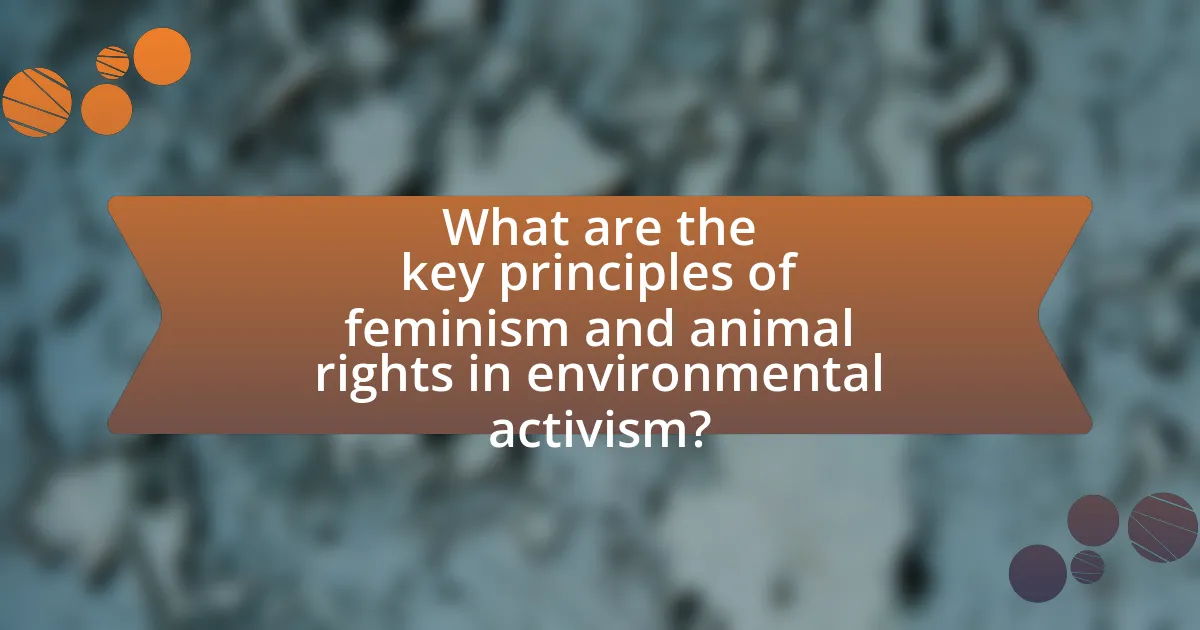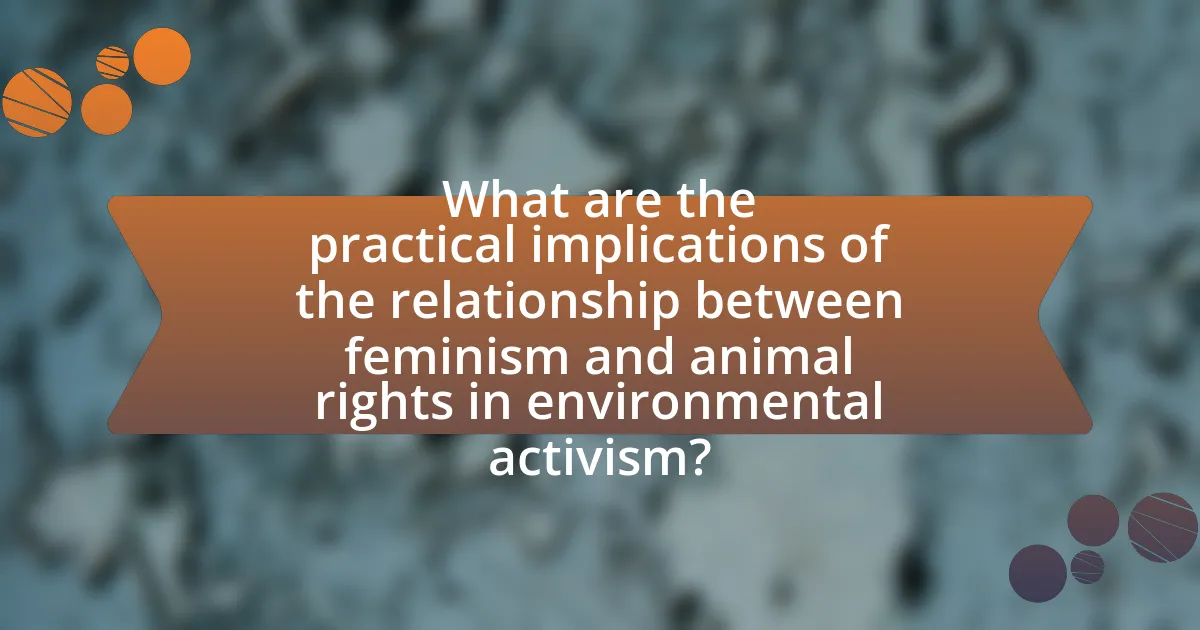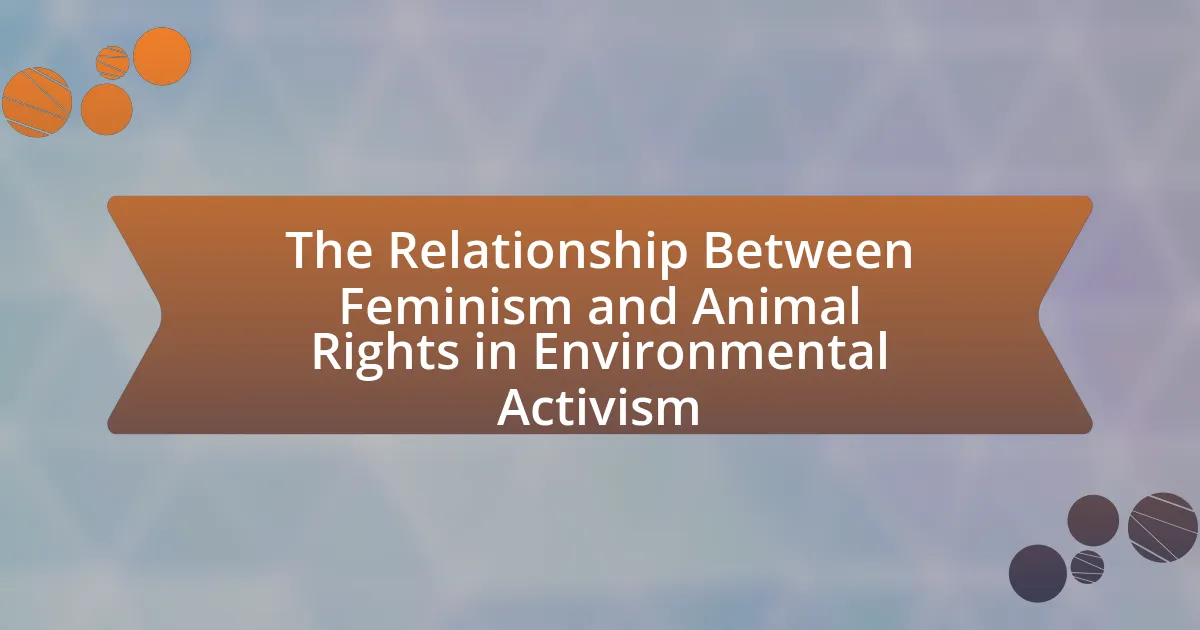The article examines the relationship between feminism and animal rights within the context of environmental activism, highlighting their shared focus on social justice and the critique of oppressive systems. It discusses how both movements address the exploitation of marginalized groups, emphasizing the interconnectedness of gender inequality and speciesism. Key themes include historical connections between feminist movements and animal rights advocacy, the influence of feminist theories on animal rights perspectives, and the importance of an intersectional approach in promoting inclusivity and effective activism. The article also explores practical implications, strategies for collaboration, and successful case studies that illustrate the synergy between these movements in advocating for a more equitable and sustainable future.

What is the relationship between feminism and animal rights in environmental activism?
Feminism and animal rights intersect in environmental activism through their shared focus on social justice and the critique of systems of oppression. Both movements advocate for the rights of marginalized groups, with feminism addressing gender inequality and animal rights confronting speciesism. This relationship is evident in the work of activists who argue that the exploitation of women and animals stems from similar patriarchal structures. For instance, scholars like Carol J. Adams in “The Sexual Politics of Meat” illustrate how the objectification of women parallels the treatment of animals in society. This connection emphasizes the need for an inclusive approach to environmental activism that recognizes the interconnectedness of all forms of oppression.
How do feminism and animal rights intersect in the context of environmental activism?
Feminism and animal rights intersect in environmental activism through their shared focus on the exploitation and oppression of marginalized beings. Both movements advocate for justice, emphasizing the interconnectedness of social and ecological issues. For instance, feminist theorists like Carol J. Adams argue that the domination of women and animals stems from patriarchal structures that prioritize exploitation for profit and control. This perspective is supported by research indicating that environmental degradation often disproportionately affects women and marginalized communities, highlighting the need for an inclusive approach to activism that addresses both gender and animal rights. By recognizing these intersections, activists can create more holistic strategies that promote sustainability and equity.
What historical connections exist between feminist movements and animal rights advocacy?
Feminist movements and animal rights advocacy share historical connections rooted in the critique of oppression and the fight against systemic injustices. Both movements emerged from a common understanding that marginalized groups, including women and animals, experience exploitation and subjugation. For instance, early feminist thinkers like Mary Wollstonecraft and later activists such as Carol J. Adams highlighted the parallels between the treatment of women and animals, arguing that both are often objectified and dehumanized in patriarchal societies. Adams’ work, particularly in “The Sexual Politics of Meat,” illustrates how the domination of women and animals is intertwined, emphasizing the need for solidarity across these movements. This intersectionality has led to collaborative efforts in advocacy, where feminists have incorporated animal rights into their agendas, promoting a broader understanding of justice that encompasses both gender and species.
How do feminist theories inform animal rights perspectives?
Feminist theories inform animal rights perspectives by emphasizing the interconnectedness of oppression faced by both women and non-human animals. This perspective highlights how patriarchal structures contribute to the exploitation of both groups, suggesting that the domination of women parallels the domination of animals. For instance, feminist scholars like Carol J. Adams argue that the language and practices surrounding animal consumption reflect broader societal attitudes towards gender and power dynamics. This intersectional approach encourages a more inclusive understanding of rights that advocates for the liberation of all marginalized beings, thereby reinforcing the ethical imperative to challenge both sexism and speciesism.
Why is the relationship between feminism and animal rights important for environmental activism?
The relationship between feminism and animal rights is important for environmental activism because both movements challenge systems of oppression and advocate for the rights of marginalized beings. Feminism critiques patriarchal structures that exploit both women and animals, while animal rights activism addresses the ethical treatment of non-human animals, highlighting the interconnectedness of social justice issues. Research indicates that integrating feminist perspectives into environmental activism can lead to more holistic approaches that consider the welfare of all living beings, as seen in works like “Ecofeminism: Linking Theory and Practice” by Greta Gaard, which emphasizes the parallels between the exploitation of women and animals in environmental degradation. This intersectional approach fosters a more inclusive and effective environmental movement.
What role do gender dynamics play in environmental issues related to animal rights?
Gender dynamics significantly influence environmental issues related to animal rights by shaping perspectives, advocacy strategies, and policy priorities. Women often lead grassroots movements that emphasize compassion and ethical treatment of animals, reflecting feminist values that prioritize care and interconnectedness. Research indicates that women are more likely to engage in pro-environmental behaviors and support animal rights initiatives, as seen in studies highlighting their predominant roles in organizations like the Animal Legal Defense Fund and the Humane Society. Furthermore, gendered experiences of oppression can create a unique understanding of the exploitation faced by both women and animals, fostering solidarity in activism. This intersectional approach enhances the effectiveness of campaigns aimed at promoting animal welfare and environmental sustainability.
How can understanding this relationship enhance environmental activism strategies?
Understanding the relationship between feminism and animal rights can enhance environmental activism strategies by fostering a more inclusive and intersectional approach. This relationship highlights the interconnectedness of various forms of oppression, allowing activists to address environmental issues through a lens that considers gender, species, and social justice. For instance, research indicates that movements that integrate feminist perspectives often mobilize broader coalitions, increasing participation and support (Gaard, 2011, “Ecofeminism: Women, Animals, Nature”). By recognizing the shared struggles against exploitation, activists can develop strategies that resonate with diverse communities, ultimately leading to more effective advocacy and policy change.

What are the key principles of feminism and animal rights in environmental activism?
The key principles of feminism and animal rights in environmental activism include the interconnectedness of social justice, the critique of hierarchical structures, and the advocacy for the rights of marginalized beings. Feminism emphasizes the need to address gender inequalities and the exploitation of women, while animal rights advocates highlight the ethical treatment of non-human animals and the environmental impacts of their exploitation. Both movements challenge systems of oppression, asserting that the domination of one group often leads to the domination of others, as seen in the works of scholars like Carol J. Adams, who discusses the “politics of meat” and its ties to patriarchy. This intersectional approach underscores the importance of recognizing how issues of gender, species, and environmental degradation are intertwined, advocating for a holistic view of activism that seeks justice for all oppressed entities.
What core values do feminists and animal rights activists share?
Feminists and animal rights activists share core values of social justice, empathy, and the belief in the inherent rights of all sentient beings. Both movements advocate for the liberation of marginalized groups, emphasizing the importance of recognizing and addressing systemic oppression. For instance, feminists fight against gender-based violence and discrimination, while animal rights activists oppose speciesism and cruelty towards animals. This intersectionality highlights a shared commitment to challenging hierarchies and promoting equality across different domains of life. Research by Carol J. Adams in “The Sexual Politics of Meat” illustrates how both movements critique the exploitation of bodies, whether human or animal, reinforcing their common ethical stance.
How do these shared values influence their approaches to environmental issues?
Shared values in feminism and animal rights significantly influence their approaches to environmental issues by promoting interconnectedness and advocating for holistic solutions. Feminism emphasizes social justice and equality, which aligns with animal rights’ focus on the ethical treatment of all beings, leading to a unified stance against environmental degradation. This synergy manifests in activism that addresses systemic oppression, highlighting how exploitation of the environment parallels the exploitation of marginalized groups. For instance, both movements often collaborate on campaigns that challenge industrial practices harmful to ecosystems and vulnerable populations, demonstrating a commitment to sustainable and equitable practices.
What are the differences in priorities between feminist and animal rights movements?
The feminist movement primarily prioritizes gender equality and the rights of women, focusing on issues such as reproductive rights, workplace equality, and combating gender-based violence. In contrast, the animal rights movement emphasizes the ethical treatment of non-human animals, advocating against animal cruelty, exploitation, and promoting animal welfare.
While both movements seek to address systemic injustices, their core priorities differ significantly; feminists concentrate on human social structures and gender dynamics, whereas animal rights activists focus on the moral consideration of animals and their rights. For example, feminist theorists like Carol J. Adams argue that patriarchal structures contribute to the oppression of both women and animals, suggesting an intersectional approach, but the primary objectives remain distinct.
How do intersectionality and inclusivity shape the dialogue between feminism and animal rights?
Intersectionality and inclusivity significantly shape the dialogue between feminism and animal rights by highlighting the interconnectedness of various forms of oppression. Feminism, which advocates for gender equality, recognizes that issues of race, class, and speciesism are intertwined, thus promoting a more holistic approach to social justice. For instance, scholars like Carol J. Adams argue that the exploitation of women and animals stems from similar patriarchal structures, emphasizing the need for a unified movement that addresses these overlapping injustices. This perspective fosters a dialogue that encourages collaboration between feminist and animal rights activists, leading to a more comprehensive understanding of how systemic inequalities affect both women and non-human animals.
What challenges arise when addressing intersectional issues in environmental activism?
Addressing intersectional issues in environmental activism presents challenges such as the difficulty in integrating diverse perspectives and the risk of marginalizing certain voices. Activists often struggle to balance the needs of various groups, including women, people of color, and marginalized communities, which can lead to conflicts over priorities and resources. For instance, research by the Environmental Justice Foundation highlights that marginalized communities disproportionately face environmental hazards, yet their concerns may be overlooked in mainstream environmental movements. This lack of representation can hinder effective collaboration and dilute the impact of activism aimed at achieving comprehensive environmental justice.
How can activists promote inclusivity within these movements?
Activists can promote inclusivity within movements by actively engaging diverse voices and perspectives, ensuring representation from marginalized groups. This approach fosters a more comprehensive understanding of issues, as seen in the intersectional framework of feminism, which emphasizes the importance of including various identities and experiences. Research indicates that inclusive movements are more effective; for instance, a study published in the Journal of Environmental Psychology found that diverse groups generate more innovative solutions to environmental challenges. By prioritizing inclusivity, activists can create a stronger, more unified front that addresses the interconnectedness of feminism, animal rights, and environmental activism.

What are the practical implications of the relationship between feminism and animal rights in environmental activism?
The practical implications of the relationship between feminism and animal rights in environmental activism include the promotion of intersectional approaches that address both human and non-human oppression. This relationship fosters a holistic understanding of environmental issues, emphasizing that the exploitation of animals and the oppression of marginalized groups are interconnected. For instance, feminist scholars like Carol J. Adams argue that patriarchal structures contribute to both animal exploitation and gender inequality, suggesting that addressing one can lead to progress in the other. Additionally, organizations that integrate feminist and animal rights perspectives often advocate for policies that protect both the environment and vulnerable populations, thereby enhancing the effectiveness of environmental activism. This intersectional framework can lead to more inclusive movements that resonate with a broader audience, ultimately driving more significant social and environmental change.
How can activists effectively integrate feminist and animal rights perspectives in their work?
Activists can effectively integrate feminist and animal rights perspectives by recognizing the interconnectedness of oppression faced by both women and animals. This integration can be achieved through collaborative campaigns that highlight shared values, such as empathy and justice, and by addressing systemic issues like patriarchy and speciesism. For instance, organizations like the Feminist Animal Studies Network emphasize the importance of understanding how gender and species intersect, advocating for a holistic approach that considers the rights of both women and animals. Research indicates that movements that unite these perspectives can enhance advocacy efforts, as seen in campaigns that address both environmental degradation and social inequality, thereby fostering a more inclusive and effective activism strategy.
What strategies can be employed to raise awareness about this relationship?
To raise awareness about the relationship between feminism and animal rights in environmental activism, educational campaigns can be employed. These campaigns can include workshops, seminars, and online courses that highlight the interconnectedness of gender equality and animal welfare, emphasizing how both movements address systemic oppression. Research indicates that integrating feminist perspectives into animal rights discussions can enhance understanding and engagement, as seen in studies like “Feminism and Animal Rights: A Critical Perspective” by Carol J. Adams, which illustrates the parallels between the struggles for women’s rights and animal rights. Additionally, social media campaigns can amplify voices from both movements, creating a broader dialogue that encourages collaboration and solidarity.
How can collaboration between feminist and animal rights organizations be fostered?
Collaboration between feminist and animal rights organizations can be fostered through shared advocacy for social justice and the intersectionality of oppression. Both movements address systemic inequalities, making joint campaigns and educational initiatives effective in raising awareness about the connections between gender-based violence and animal exploitation. For instance, organizations can co-host events that highlight how patriarchal structures contribute to both human and animal suffering, thereby creating a unified front. Research indicates that intersectional approaches can enhance activism effectiveness, as seen in the work of scholars like Carol J. Adams, who emphasizes the link between feminism and vegetarianism in her book “The Sexual Politics of Meat.” By leveraging these shared values and goals, feminist and animal rights organizations can create a more cohesive and impactful movement.
What are some successful case studies that illustrate this relationship in action?
Successful case studies illustrating the relationship between feminism and animal rights in environmental activism include the work of organizations like the Feminist Animal Studies Network and the Animal Liberation Front. The Feminist Animal Studies Network promotes interdisciplinary research that connects feminist theory with animal rights, highlighting how both movements challenge oppression and advocate for justice. The Animal Liberation Front has engaged in direct action campaigns that emphasize the interconnectedness of human and non-human animal rights, often aligning with feminist principles of equality and justice. These organizations demonstrate how feminist perspectives can enhance animal rights activism, leading to more inclusive environmental movements.
What lessons can be learned from these case studies for future activism?
Future activism can learn the importance of intersectionality from these case studies, as they demonstrate that addressing multiple forms of oppression can strengthen movements. For instance, the collaboration between feminist and animal rights activists has shown that shared goals, such as challenging patriarchal structures and advocating for the rights of all sentient beings, can create a more inclusive and powerful advocacy framework. Research indicates that movements that embrace intersectionality, like the one highlighted in the case studies, are more effective in mobilizing diverse groups and achieving broader social change. This approach not only enhances solidarity among activists but also addresses systemic issues more comprehensively, leading to sustainable activism outcomes.
What practical tips can activists follow to enhance their efforts in this area?
Activists can enhance their efforts in the intersection of feminism and animal rights by adopting a multi-faceted approach that includes education, collaboration, and advocacy. First, educating themselves and their communities about the connections between gender equality and animal rights can foster a deeper understanding of the issues at hand. Research indicates that both movements share common goals of justice and liberation, which can be highlighted in workshops and discussions.
Second, collaboration with organizations that focus on both feminist and animal rights issues can amplify their impact. For instance, partnerships with groups like the Feminist Animal Studies Network can provide resources and support for joint initiatives.
Third, activists should engage in advocacy that addresses both feminist and animal rights perspectives in policy-making. This can involve lobbying for legislation that protects both women’s rights and animal welfare, demonstrating the interconnectedness of these causes.
By implementing these strategies, activists can create a more inclusive and effective movement that addresses the complexities of environmental activism.
